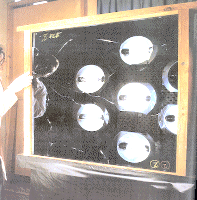Glass and Thermal Stress

Thermal Stress is created when one area of a glass pane gets hotter than an adjacent area. If the stress is too great then the glass will crack. The stress level at which the glass will break is governed by several factors. Toughened glass is very resilient and not prone to failing due to thermal stress. Laminated glass and annealed glass behave in a similar way. Thicker glasses are less tolerant. Glass containing wire is more vulnerable. The edge quality of the glass can play a part. Glass with damaged edges will take less stress than clean cut glass. A good clean cut edge is the best finish along with fully polished edges. Ground edges and arrissed edges may not be as good. A ground or arrissed edge is a series of small defects around the glass. The effect brings all the defects to an average level and may at best be only more predictable than a glass with more random damage.
The temperature difference for a location can be calculated and breakage due to thermal reasons eliminated. To asses the thermal risk we need to know the following information listed in the Pilkington Thermal safety check Form:
asses the thermal risk we need to know the following information listed in the Pilkington Thermal safety check Form:
- Location of the building
- Orientation
- Type of glass being used including details of the insulating glass units
- Size of building overhang if present
- Size of mullion and transom caps if present
- Details of any internal or external blind/louvres
- Details of any back up i.e where a panel makes up a level to a floor or ceiling behind the glass allowing hot air to be trapped and reflecting back at the glass.
- The framing material including thermal breaks and frame colour.
- The window size and if it opens. I.e. changes the angle to the sun.
- Details of internal heating systems.
- Any other details like other buildings or trees casting a shadow onto the glass.
During the year the sun changes its path through the sky. If the glass in a building is subject to excess thermal stress it would be expected to have problems in its first year of use. The most challenging periods are in spring and autumn when the sun angles are low and the nights are cold. Mid summer the edges of the glass will be warmer anyway and the sun's path is more directly overhead putting less direct heat into the glass.
Solar control glass either reflects energy or absorbs it to reradiate the heat outwards. By its nature it gets hotter that clear glass and glass that is designed for thermal efficiency alone like Pilkington K Glass™ and Pilkington Optitherm SN™. We would always recommend a thermal safety check on solar control glass and thick glass constructions including Fire resistant glass.
In many cases where thermal breakage is suspected the use of the building has changed in some way. Schools have a tendency to stick posters on the glass of childrens art work. Offices can add blinds where none were predicted or films for solar control or blast resistance have been added as an afterthought. Most installations of glass are well within the operating tolerance but in some cases the unexpected changes can put the stress beyond the limits.
Glass is also sensitive to thermal stress produced by fire. Special design considerations need to be taken where fire protection is a key concern, either for property protection or life safety.